Renewable Energy Use in America, Europe and the World
The current climate crisis is one of the gravest dangers to our planet as we know it. Sea levels are rising higher and higher each year. Temperatures are hotter than ever before. Glaciers have shrunk to record levels.
For our communities on planet earth this makes for a vicious cocktail that is brewing for disaster. A disaster that could lead us down the path of exponentially long droughts, an ice-free arctic and, ultimately, a devastating worldwide famine.
This doesn’t have to be the only future for us on earth. There are numerous ways that we, as a human race, can end the climate crisis and bring about a new era of clean energy and a cleaner planet. Renewables for instance. Renewable energy is just one of the ways that we can cut our oil addiction, reduce our dependence on fossil fuels as a whole and put the process of cleaning our planet into place.
But where are we up to on renewables? How many of us are embracing renewables as the future? And how does your country compare to other countries around the world when it comes to embracing renewable energy?
As this really does have to be a worldwide commitment, we’ve analysed data from all around the world and have visualised a variety of statistics on renewable energies to answer these questions.
As we are based in the UK, we’ve also done a more specific analysis for the different regions of the UK that can be found at the bottom of this article. Read on to learn more about renewable energy use and the types of renewable energy in use in countries all around the world.
Europe Renewable Energy Consumption as a total of energy consumption
 Europe is THE continent of culture. France has the art, wine and romance. Italy has the passion, history and pasta. And Ireland is the country of warming stews, Guinness and charm.
As the continent that birthed the renaissance period it is no surprise that Europe has a great passion and support for renewable energy. As a continent only a handful of countries consume less than 10% of their energy from renewables. In fact, over 50% of the European countries analysed find at least 20% of their energy needs from renewable sources.
The biggest players in the European renewable industry are the Nordic countries in Iceland, Norway and Sweden, with a surprise in Liechtenstein making up the top 4. Iceland impressively sources over 76% of its energy needs from renewable sources with geothermal and hydropower supporting the 300,000 strong population.
The real surprise in this analysis though is Liechtenstein. After they came in 2nd we decided to look at their renewable energy growth and sources a little closer. In 1990 they sourced exactly 0% of their energy from renewable sources. Today they source over 60% of their energy from Solar, Wind and Hydropower. Amazing growth of the renewable industry and an example to other European countries of what can be achieved with a little dedication and a solid plan.
North America Renewable Energy Consumption as a total of energy consumption
Europe is THE continent of culture. France has the art, wine and romance. Italy has the passion, history and pasta. And Ireland is the country of warming stews, Guinness and charm.
As the continent that birthed the renaissance period it is no surprise that Europe has a great passion and support for renewable energy. As a continent only a handful of countries consume less than 10% of their energy from renewables. In fact, over 50% of the European countries analysed find at least 20% of their energy needs from renewable sources.
The biggest players in the European renewable industry are the Nordic countries in Iceland, Norway and Sweden, with a surprise in Liechtenstein making up the top 4. Iceland impressively sources over 76% of its energy needs from renewable sources with geothermal and hydropower supporting the 300,000 strong population.
The real surprise in this analysis though is Liechtenstein. After they came in 2nd we decided to look at their renewable energy growth and sources a little closer. In 1990 they sourced exactly 0% of their energy from renewable sources. Today they source over 60% of their energy from Solar, Wind and Hydropower. Amazing growth of the renewable industry and an example to other European countries of what can be achieved with a little dedication and a solid plan.
North America Renewable Energy Consumption as a total of energy consumption
 The North American continent defines the vast inequalities in our world. In the same region you have the vastly rich United States, Canada and Caribbean Islands and then you also have the desperately poor Haiti, Jamaica and Mexico.
While it is no surprise that the United States is the world leader in renewable energy, providing the world with the technology and funding to make renewables a reality, are they embracing renewables to the extent that they should or could?
Interestingly, and whether this is due to money or politics, the United States only source 8% of their total energy consumption from renewable sources. Compare that to Canada who source over 20% of their energy from renewables, the question has to be raised: are US politicians doing enough to support the renewable industry?
Analysing the data further we found that it was the poorer countries in Haiti, Guatemala and Nicaragua who are embracing renewables in North America.
Making up the top three, Haiti source 78% of their energy from renewables, Guatemala 59% and Nicaragua 51%. Is this push towards renewables by poorer countries a reaction to rising fossil fuel prices?
Africa Renewable Energy Consumption as a total of energy consumption
The North American continent defines the vast inequalities in our world. In the same region you have the vastly rich United States, Canada and Caribbean Islands and then you also have the desperately poor Haiti, Jamaica and Mexico.
While it is no surprise that the United States is the world leader in renewable energy, providing the world with the technology and funding to make renewables a reality, are they embracing renewables to the extent that they should or could?
Interestingly, and whether this is due to money or politics, the United States only source 8% of their total energy consumption from renewable sources. Compare that to Canada who source over 20% of their energy from renewables, the question has to be raised: are US politicians doing enough to support the renewable industry?
Analysing the data further we found that it was the poorer countries in Haiti, Guatemala and Nicaragua who are embracing renewables in North America.
Making up the top three, Haiti source 78% of their energy from renewables, Guatemala 59% and Nicaragua 51%. Is this push towards renewables by poorer countries a reaction to rising fossil fuel prices?
Africa Renewable Energy Consumption as a total of energy consumption
 As the second largest continent on earth and home to over 1.2 billion people, Africa is one of the most impoverished places on earth. Once population is accounted for, Africa has the smallest GDP in the world, with an estimated GDP 10 times smaller than that of North America, Asia and Europe.
In terms of renewably energy though, Africa is one of the world leaders. Exactly 30 countries source over 70% of their energy from renewables, with only five countries sourcing less than 10% of their energy from renewable sources.
Similar to our analysis in the North American section, is this push towards renewables by poorer countries a reaction to the rising fossil fuel prices? The pattern so far seems to suggest this to be true.
Asia Renewable Energy Consumption as a total of energy consumption
As the second largest continent on earth and home to over 1.2 billion people, Africa is one of the most impoverished places on earth. Once population is accounted for, Africa has the smallest GDP in the world, with an estimated GDP 10 times smaller than that of North America, Asia and Europe.
In terms of renewably energy though, Africa is one of the world leaders. Exactly 30 countries source over 70% of their energy from renewables, with only five countries sourcing less than 10% of their energy from renewable sources.
Similar to our analysis in the North American section, is this push towards renewables by poorer countries a reaction to the rising fossil fuel prices? The pattern so far seems to suggest this to be true.
Asia Renewable Energy Consumption as a total of energy consumption
 As the largest continent on earth, Asia has a population greater than that of all the other continents combined. Standing at 4.4 billion people strong, Asian countries have the mammoth task of supplying all their citizens with electricity. As it stands, experts say nearly 30% of Asia still has no access to electricity.
Renewables play a huge role in Asia’s energy consumption. As a world total, Asia generates 40% of the world’s renewable energy, with China playing a huge part in the investment, development and growth of renewable technologies.
With China’s support, countries like Laos, Bhutan and Myanmar are leading the way forward with over 70% of their electricity coming from renewables. One country that stands out in particular is the speedy development of Cambodia. From 0% of their energy generated using renewables in 1990 to now generating 67% of their energy from renewables, Cambodia has invested wisely in Biogas, Biofuel, Geothermal and Solar power energy.
South America Renewable Energy Consumption as a total of energy consumption
As the largest continent on earth, Asia has a population greater than that of all the other continents combined. Standing at 4.4 billion people strong, Asian countries have the mammoth task of supplying all their citizens with electricity. As it stands, experts say nearly 30% of Asia still has no access to electricity.
Renewables play a huge role in Asia’s energy consumption. As a world total, Asia generates 40% of the world’s renewable energy, with China playing a huge part in the investment, development and growth of renewable technologies.
With China’s support, countries like Laos, Bhutan and Myanmar are leading the way forward with over 70% of their electricity coming from renewables. One country that stands out in particular is the speedy development of Cambodia. From 0% of their energy generated using renewables in 1990 to now generating 67% of their energy from renewables, Cambodia has invested wisely in Biogas, Biofuel, Geothermal and Solar power energy.
South America Renewable Energy Consumption as a total of energy consumption
 South America is the most ecologically diverse continent on earth. Home to a stunning array of tropical rainforests, arid deserts, vast water systems and majestic mountain ranges, South America has one of the most important roles to play in tackling the current climate crisis.
So where are they up to on renewable energy? Well, as a continent, the 12 sovereign states contribute 15% of the world’s renewable energy capacity. When you consider the GDP of the region, this is quite impressive. The biggest generator of renewables is Brazil which, as you will see below, generates the highest MW of energy in the Bioenergy industry and is the third highest generator of energy using hydropower.
In terms of renewables as a total of energy consumption, Paraguay tops the leaderboard generating 63% of its energy from renewable sources. Uruguay and Honduras also perform well with each generating at least 50% of their energy from renewable sources.
Australasia Renewable Energy Consumption as a total of energy consumption
South America is the most ecologically diverse continent on earth. Home to a stunning array of tropical rainforests, arid deserts, vast water systems and majestic mountain ranges, South America has one of the most important roles to play in tackling the current climate crisis.
So where are they up to on renewable energy? Well, as a continent, the 12 sovereign states contribute 15% of the world’s renewable energy capacity. When you consider the GDP of the region, this is quite impressive. The biggest generator of renewables is Brazil which, as you will see below, generates the highest MW of energy in the Bioenergy industry and is the third highest generator of energy using hydropower.
In terms of renewables as a total of energy consumption, Paraguay tops the leaderboard generating 63% of its energy from renewable sources. Uruguay and Honduras also perform well with each generating at least 50% of their energy from renewable sources.
Australasia Renewable Energy Consumption as a total of energy consumption
 Australasia and Oceania is the most sparsely populated continent on earth (apart for Antarctica, obviously). Made up of the three giant islands in Australia, New Zealand and Papua New Guinea the continent is comprised of tropical rainforests, arid desert, volcanoes and dry grasslands.
So how does the Australasia and Oceania region compare in a global renewable context? Analysing data for 16 different islands in the region we found that the Solomon Islands had the highest consumption of renewables as a total of energy consumption at 62%, followed by Papua New Guinea’s 50% and Samoa’s 42%. But across Australasia the rates of renewable energy consumption to a total of energy consumption hits below 10%. The richest country in the region Australia is one of the biggest surprises with only 9% of their energy coming from renewable sources.
Most Used Renewable Energy Source – Worldwide
Australasia and Oceania is the most sparsely populated continent on earth (apart for Antarctica, obviously). Made up of the three giant islands in Australia, New Zealand and Papua New Guinea the continent is comprised of tropical rainforests, arid desert, volcanoes and dry grasslands.
So how does the Australasia and Oceania region compare in a global renewable context? Analysing data for 16 different islands in the region we found that the Solomon Islands had the highest consumption of renewables as a total of energy consumption at 62%, followed by Papua New Guinea’s 50% and Samoa’s 42%. But across Australasia the rates of renewable energy consumption to a total of energy consumption hits below 10%. The richest country in the region Australia is one of the biggest surprises with only 9% of their energy coming from renewable sources.
Most Used Renewable Energy Source – Worldwide
 Next, we took a closer look at which of the main five renewables each country around the world utilises the most. We’ve seen that renewable consumption varies greatly from country to country, but how much does the type of renewable change from country to country?
Analysing a variety of datasets we found that hydropower is by far and away the most popular type of renewable energy. The only real exceptions were a cluster of countries in the Middle East and North East Africa who’ve embraced solar power, and a number of European countries in the likes of Germany, Spain and Poland who’ve embraced wind power. The other small exception is Kenya who surprisingly generates a large percentage of its energy from geothermal sources.
Interestingly, Kenya is one of the world leaders in renewable energies. Having embraced Geothermal in the Rift Valley, Kenyans have also embraced Wind, Hydro and Bioenergy in impressive numbers for an African country. In terms of MW capacity they generate 26% of Africa’s entire renewable energy. Impressive.
Top 10 Countries with Highest use of Renewable Energy – 2016
We also looked more specifically at which countries produce the most energy from renewable sources per renewable type. Analysing data from across the solar, wind, hydropower, geothermal and bioenergy industries we’ve noted down the top 10 in the graphic below. In terms of all round performance China is impressively the world’s greatest when it comes to renewable energy. Following hot on the heels in almost all renewable types is the United States.
While the two superpowers in the US and China featuring in the top 10 of this analysis will be of little surprise, there are some interesting countries featuring in the top 10 of each renewable type that may be a little more unexpected. The Philippines for example has embraced Geothermal energy to the tune of nearly 2000 MW capacity a year and they also feature in our top 10 for solar power too. Another surprise is Brazil, which features in the top 10 for bioenergy production, hydropower and wind power.
Top 10 Countries with Highest Use of Renewable Energy – 2000
So how have things changed over the last 16 years? To find out we’ve taken a closer look at the data per renewable type in the year 2000. Unsurprisingly, it will not be hard to believe that we are generating far more energy in 2016 with renewables than 16 years ago. For example in the year 2000 the top country in the United States was producing 595 MW of energy using solar power. In 2016, the top country in Japan is producing over 41,000 MW.
Another surprise is how the Germans have loosened their dominance over the renewable industry in the last 16 years. Featuring in the top three spots for almost every renewable type in the year 2000, they’ve now slipped down the leaderboard with countries like China and Brazil investing heavily into renewable energies.
Interestingly, you can see the German pattern in a number of European countries. In the year 2000, countries like the Netherlands, Greece and Switzerland featured in the top 10 for a range of renewable types. Today they have moved down the rankings with the likes of India, the Philippines and Turkey moving into the top 10.
Total Renewable Energy Analysis – Regional – 2000 – 2016
We also looked at the data from a wider more regional perspective. As you can see in the interactive below, in the year 2000, 75% of the world’s total renewable energy capacity was equally split between Europe, Asia and North America. South America, Eurasia, Africa and the Middle East make up the other 25%.
However, things have changed drastically on a regional level over the last 16 years. Today, Asia has grown to be the biggest generator of electricity from renewable sources making up 40% of the world total. Interestingly, Europe have maintained their share only losing 1% of the total capacity, while North America as a whole drops off quite significantly losing 7% of the total renewable energy share.
UK Wind, Solar, Wave, Tidal, Landfill Gas, Sewage Gas, Other Bio Energy
Next, we took a closer look at which of the main five renewables each country around the world utilises the most. We’ve seen that renewable consumption varies greatly from country to country, but how much does the type of renewable change from country to country?
Analysing a variety of datasets we found that hydropower is by far and away the most popular type of renewable energy. The only real exceptions were a cluster of countries in the Middle East and North East Africa who’ve embraced solar power, and a number of European countries in the likes of Germany, Spain and Poland who’ve embraced wind power. The other small exception is Kenya who surprisingly generates a large percentage of its energy from geothermal sources.
Interestingly, Kenya is one of the world leaders in renewable energies. Having embraced Geothermal in the Rift Valley, Kenyans have also embraced Wind, Hydro and Bioenergy in impressive numbers for an African country. In terms of MW capacity they generate 26% of Africa’s entire renewable energy. Impressive.
Top 10 Countries with Highest use of Renewable Energy – 2016
We also looked more specifically at which countries produce the most energy from renewable sources per renewable type. Analysing data from across the solar, wind, hydropower, geothermal and bioenergy industries we’ve noted down the top 10 in the graphic below. In terms of all round performance China is impressively the world’s greatest when it comes to renewable energy. Following hot on the heels in almost all renewable types is the United States.
While the two superpowers in the US and China featuring in the top 10 of this analysis will be of little surprise, there are some interesting countries featuring in the top 10 of each renewable type that may be a little more unexpected. The Philippines for example has embraced Geothermal energy to the tune of nearly 2000 MW capacity a year and they also feature in our top 10 for solar power too. Another surprise is Brazil, which features in the top 10 for bioenergy production, hydropower and wind power.
Top 10 Countries with Highest Use of Renewable Energy – 2000
So how have things changed over the last 16 years? To find out we’ve taken a closer look at the data per renewable type in the year 2000. Unsurprisingly, it will not be hard to believe that we are generating far more energy in 2016 with renewables than 16 years ago. For example in the year 2000 the top country in the United States was producing 595 MW of energy using solar power. In 2016, the top country in Japan is producing over 41,000 MW.
Another surprise is how the Germans have loosened their dominance over the renewable industry in the last 16 years. Featuring in the top three spots for almost every renewable type in the year 2000, they’ve now slipped down the leaderboard with countries like China and Brazil investing heavily into renewable energies.
Interestingly, you can see the German pattern in a number of European countries. In the year 2000, countries like the Netherlands, Greece and Switzerland featured in the top 10 for a range of renewable types. Today they have moved down the rankings with the likes of India, the Philippines and Turkey moving into the top 10.
Total Renewable Energy Analysis – Regional – 2000 – 2016
We also looked at the data from a wider more regional perspective. As you can see in the interactive below, in the year 2000, 75% of the world’s total renewable energy capacity was equally split between Europe, Asia and North America. South America, Eurasia, Africa and the Middle East make up the other 25%.
However, things have changed drastically on a regional level over the last 16 years. Today, Asia has grown to be the biggest generator of electricity from renewable sources making up 40% of the world total. Interestingly, Europe have maintained their share only losing 1% of the total capacity, while North America as a whole drops off quite significantly losing 7% of the total renewable energy share.
UK Wind, Solar, Wave, Tidal, Landfill Gas, Sewage Gas, Other Bio Energy
 As a British company, we also decided to take a look at the renewable energy industry in the United Kingdom. As part of the European Union, the UK has been committed to a number of initiatives that aim to solve the issue of climate change. As a key player on these initiatives the UK has been at the forefront of the renewable industry providing development and new technologies that make renewables more efficient.
So what does the renewable energy industry look like in the UK and which regions are embracing renewable energy? Well, by far and away the biggest region committed to renewable energies is Scotland. They are the biggest generator of wind and hydropower energy in the UK and they are also generating a fair chunk of the bioenergy in the UK.
Another notable region is the South West of England. This region is producing 2000 MW of solar energy each year, which is nearly four times the amount of the next biggest generating region.
The poorest region in terms of producing renewable energy is London. In total renewable energy generation they are still below 1000 MW.
Sources
https://www.gov.uk/government/statistics/energy-trends-section-6-renewables
https://www.irena.org/Publications/ReportsPaper2014New.aspx?mnu=cat&PriMenuID=36&CatID=141&type=all
https://www.gov.uk/government/collections/renewables-statistics
https://www.eia.gov/
As a British company, we also decided to take a look at the renewable energy industry in the United Kingdom. As part of the European Union, the UK has been committed to a number of initiatives that aim to solve the issue of climate change. As a key player on these initiatives the UK has been at the forefront of the renewable industry providing development and new technologies that make renewables more efficient.
So what does the renewable energy industry look like in the UK and which regions are embracing renewable energy? Well, by far and away the biggest region committed to renewable energies is Scotland. They are the biggest generator of wind and hydropower energy in the UK and they are also generating a fair chunk of the bioenergy in the UK.
Another notable region is the South West of England. This region is producing 2000 MW of solar energy each year, which is nearly four times the amount of the next biggest generating region.
The poorest region in terms of producing renewable energy is London. In total renewable energy generation they are still below 1000 MW.
Sources
https://www.gov.uk/government/statistics/energy-trends-section-6-renewables
https://www.irena.org/Publications/ReportsPaper2014New.aspx?mnu=cat&PriMenuID=36&CatID=141&type=all
https://www.gov.uk/government/collections/renewables-statistics
https://www.eia.gov/
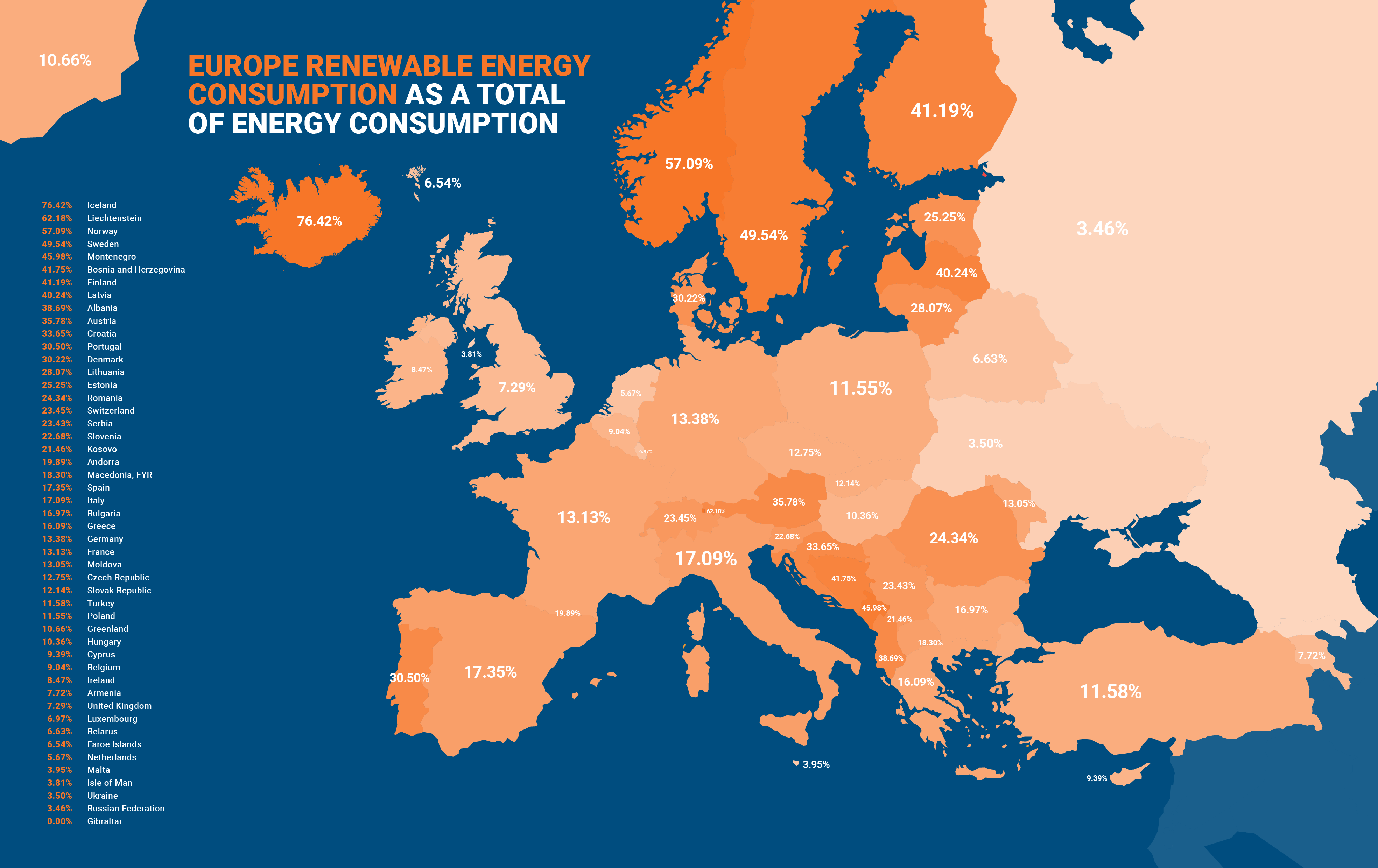 Europe is THE continent of culture. France has the art, wine and romance. Italy has the passion, history and pasta. And Ireland is the country of warming stews, Guinness and charm.
As the continent that birthed the renaissance period it is no surprise that Europe has a great passion and support for renewable energy. As a continent only a handful of countries consume less than 10% of their energy from renewables. In fact, over 50% of the European countries analysed find at least 20% of their energy needs from renewable sources.
The biggest players in the European renewable industry are the Nordic countries in Iceland, Norway and Sweden, with a surprise in Liechtenstein making up the top 4. Iceland impressively sources over 76% of its energy needs from renewable sources with geothermal and hydropower supporting the 300,000 strong population.
The real surprise in this analysis though is Liechtenstein. After they came in 2nd we decided to look at their renewable energy growth and sources a little closer. In 1990 they sourced exactly 0% of their energy from renewable sources. Today they source over 60% of their energy from Solar, Wind and Hydropower. Amazing growth of the renewable industry and an example to other European countries of what can be achieved with a little dedication and a solid plan.
North America Renewable Energy Consumption as a total of energy consumption
Europe is THE continent of culture. France has the art, wine and romance. Italy has the passion, history and pasta. And Ireland is the country of warming stews, Guinness and charm.
As the continent that birthed the renaissance period it is no surprise that Europe has a great passion and support for renewable energy. As a continent only a handful of countries consume less than 10% of their energy from renewables. In fact, over 50% of the European countries analysed find at least 20% of their energy needs from renewable sources.
The biggest players in the European renewable industry are the Nordic countries in Iceland, Norway and Sweden, with a surprise in Liechtenstein making up the top 4. Iceland impressively sources over 76% of its energy needs from renewable sources with geothermal and hydropower supporting the 300,000 strong population.
The real surprise in this analysis though is Liechtenstein. After they came in 2nd we decided to look at their renewable energy growth and sources a little closer. In 1990 they sourced exactly 0% of their energy from renewable sources. Today they source over 60% of their energy from Solar, Wind and Hydropower. Amazing growth of the renewable industry and an example to other European countries of what can be achieved with a little dedication and a solid plan.
North America Renewable Energy Consumption as a total of energy consumption
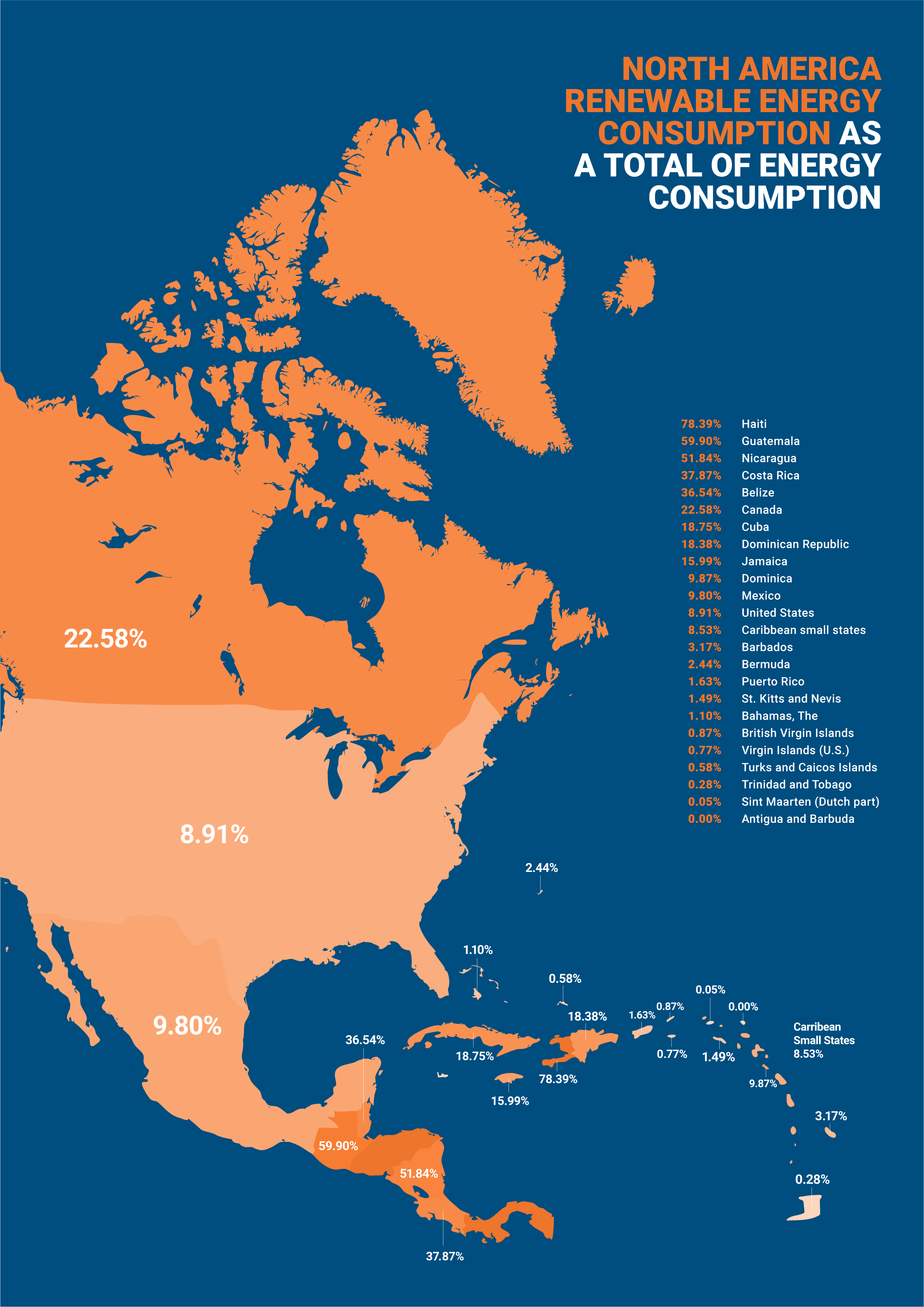 The North American continent defines the vast inequalities in our world. In the same region you have the vastly rich United States, Canada and Caribbean Islands and then you also have the desperately poor Haiti, Jamaica and Mexico.
While it is no surprise that the United States is the world leader in renewable energy, providing the world with the technology and funding to make renewables a reality, are they embracing renewables to the extent that they should or could?
Interestingly, and whether this is due to money or politics, the United States only source 8% of their total energy consumption from renewable sources. Compare that to Canada who source over 20% of their energy from renewables, the question has to be raised: are US politicians doing enough to support the renewable industry?
Analysing the data further we found that it was the poorer countries in Haiti, Guatemala and Nicaragua who are embracing renewables in North America.
Making up the top three, Haiti source 78% of their energy from renewables, Guatemala 59% and Nicaragua 51%. Is this push towards renewables by poorer countries a reaction to rising fossil fuel prices?
Africa Renewable Energy Consumption as a total of energy consumption
The North American continent defines the vast inequalities in our world. In the same region you have the vastly rich United States, Canada and Caribbean Islands and then you also have the desperately poor Haiti, Jamaica and Mexico.
While it is no surprise that the United States is the world leader in renewable energy, providing the world with the technology and funding to make renewables a reality, are they embracing renewables to the extent that they should or could?
Interestingly, and whether this is due to money or politics, the United States only source 8% of their total energy consumption from renewable sources. Compare that to Canada who source over 20% of their energy from renewables, the question has to be raised: are US politicians doing enough to support the renewable industry?
Analysing the data further we found that it was the poorer countries in Haiti, Guatemala and Nicaragua who are embracing renewables in North America.
Making up the top three, Haiti source 78% of their energy from renewables, Guatemala 59% and Nicaragua 51%. Is this push towards renewables by poorer countries a reaction to rising fossil fuel prices?
Africa Renewable Energy Consumption as a total of energy consumption
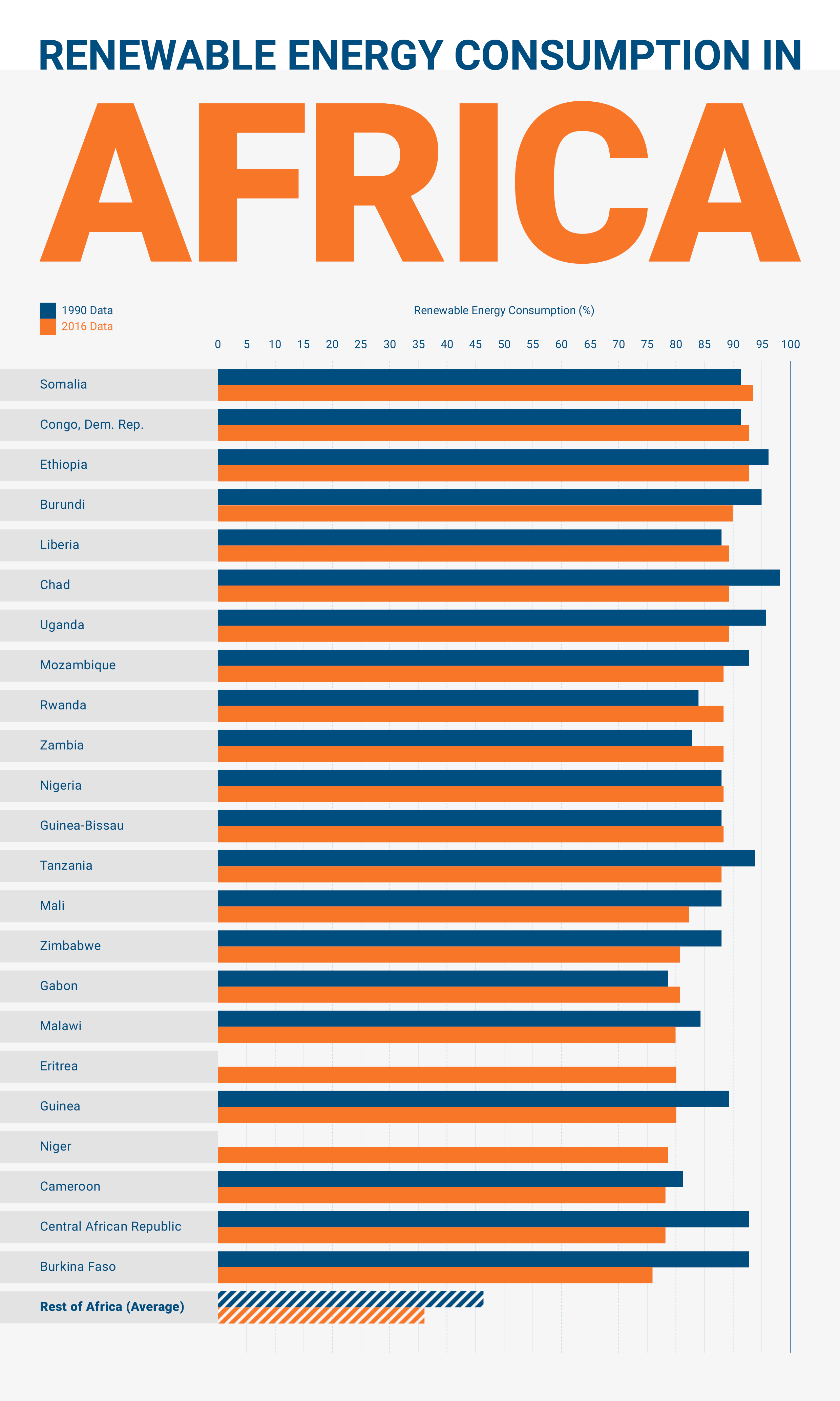 As the second largest continent on earth and home to over 1.2 billion people, Africa is one of the most impoverished places on earth. Once population is accounted for, Africa has the smallest GDP in the world, with an estimated GDP 10 times smaller than that of North America, Asia and Europe.
In terms of renewably energy though, Africa is one of the world leaders. Exactly 30 countries source over 70% of their energy from renewables, with only five countries sourcing less than 10% of their energy from renewable sources.
Similar to our analysis in the North American section, is this push towards renewables by poorer countries a reaction to the rising fossil fuel prices? The pattern so far seems to suggest this to be true.
Asia Renewable Energy Consumption as a total of energy consumption
As the second largest continent on earth and home to over 1.2 billion people, Africa is one of the most impoverished places on earth. Once population is accounted for, Africa has the smallest GDP in the world, with an estimated GDP 10 times smaller than that of North America, Asia and Europe.
In terms of renewably energy though, Africa is one of the world leaders. Exactly 30 countries source over 70% of their energy from renewables, with only five countries sourcing less than 10% of their energy from renewable sources.
Similar to our analysis in the North American section, is this push towards renewables by poorer countries a reaction to the rising fossil fuel prices? The pattern so far seems to suggest this to be true.
Asia Renewable Energy Consumption as a total of energy consumption
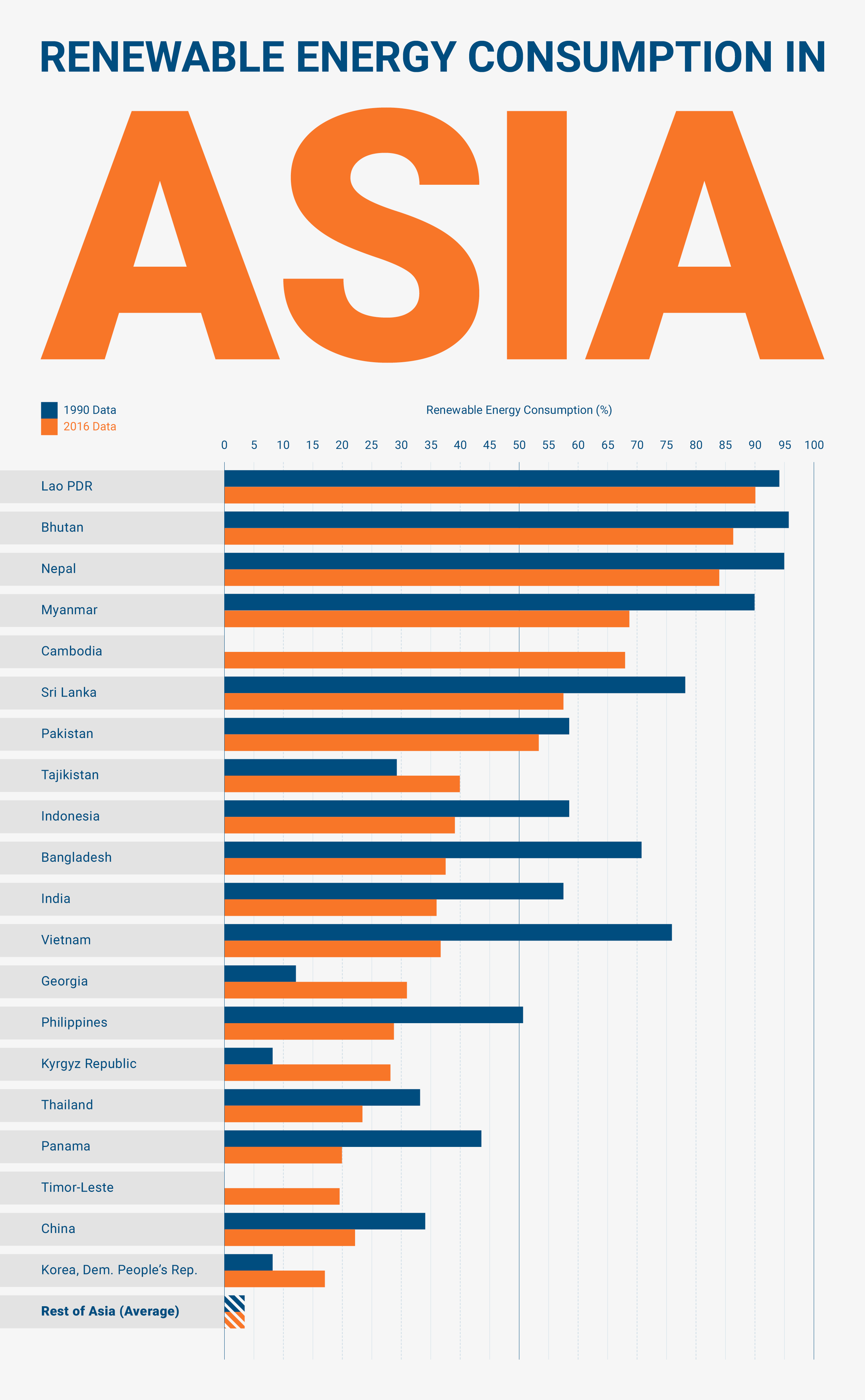 As the largest continent on earth, Asia has a population greater than that of all the other continents combined. Standing at 4.4 billion people strong, Asian countries have the mammoth task of supplying all their citizens with electricity. As it stands, experts say nearly 30% of Asia still has no access to electricity.
Renewables play a huge role in Asia’s energy consumption. As a world total, Asia generates 40% of the world’s renewable energy, with China playing a huge part in the investment, development and growth of renewable technologies.
With China’s support, countries like Laos, Bhutan and Myanmar are leading the way forward with over 70% of their electricity coming from renewables. One country that stands out in particular is the speedy development of Cambodia. From 0% of their energy generated using renewables in 1990 to now generating 67% of their energy from renewables, Cambodia has invested wisely in Biogas, Biofuel, Geothermal and Solar power energy.
South America Renewable Energy Consumption as a total of energy consumption
As the largest continent on earth, Asia has a population greater than that of all the other continents combined. Standing at 4.4 billion people strong, Asian countries have the mammoth task of supplying all their citizens with electricity. As it stands, experts say nearly 30% of Asia still has no access to electricity.
Renewables play a huge role in Asia’s energy consumption. As a world total, Asia generates 40% of the world’s renewable energy, with China playing a huge part in the investment, development and growth of renewable technologies.
With China’s support, countries like Laos, Bhutan and Myanmar are leading the way forward with over 70% of their electricity coming from renewables. One country that stands out in particular is the speedy development of Cambodia. From 0% of their energy generated using renewables in 1990 to now generating 67% of their energy from renewables, Cambodia has invested wisely in Biogas, Biofuel, Geothermal and Solar power energy.
South America Renewable Energy Consumption as a total of energy consumption
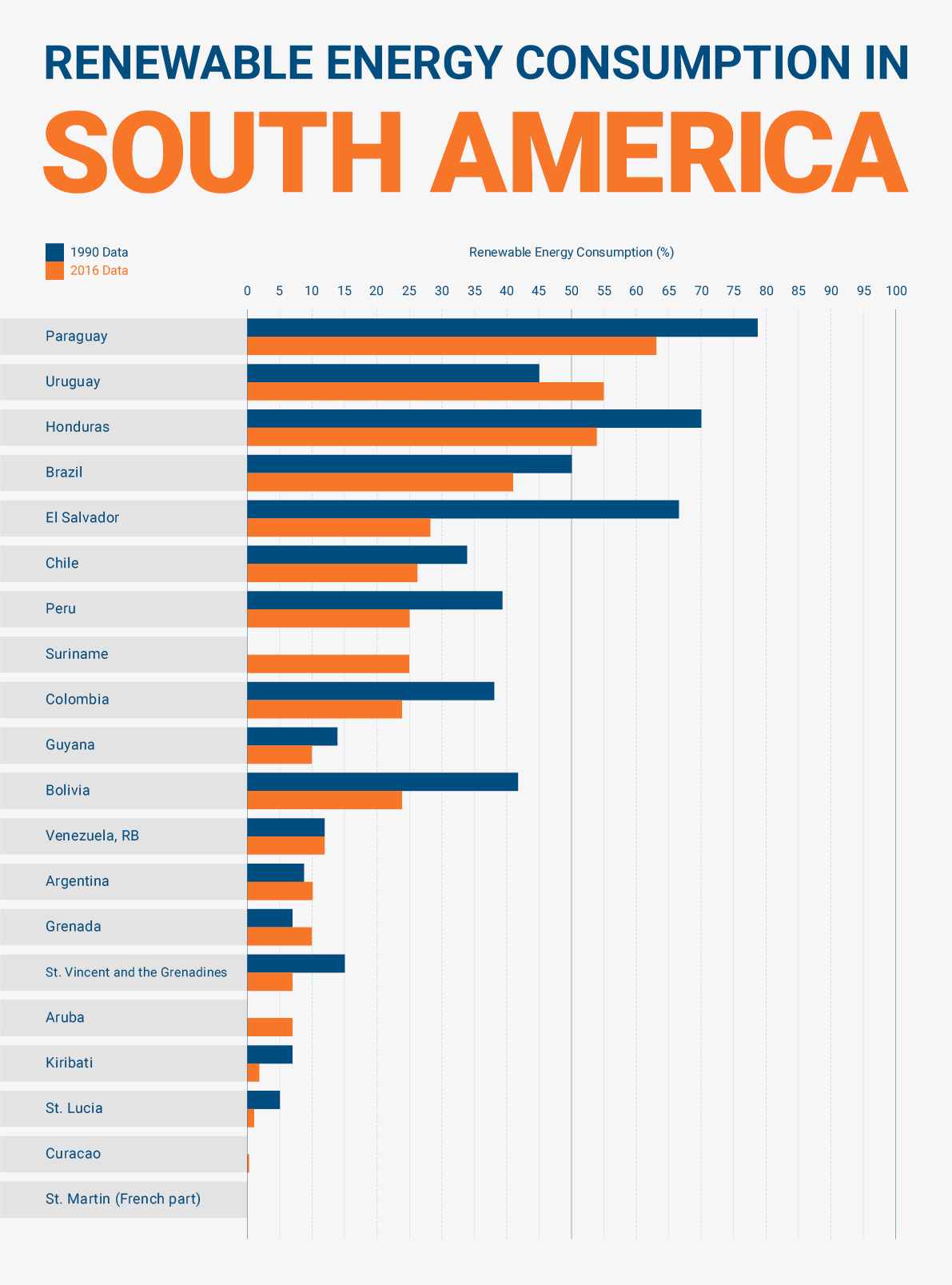 South America is the most ecologically diverse continent on earth. Home to a stunning array of tropical rainforests, arid deserts, vast water systems and majestic mountain ranges, South America has one of the most important roles to play in tackling the current climate crisis.
So where are they up to on renewable energy? Well, as a continent, the 12 sovereign states contribute 15% of the world’s renewable energy capacity. When you consider the GDP of the region, this is quite impressive. The biggest generator of renewables is Brazil which, as you will see below, generates the highest MW of energy in the Bioenergy industry and is the third highest generator of energy using hydropower.
In terms of renewables as a total of energy consumption, Paraguay tops the leaderboard generating 63% of its energy from renewable sources. Uruguay and Honduras also perform well with each generating at least 50% of their energy from renewable sources.
Australasia Renewable Energy Consumption as a total of energy consumption
South America is the most ecologically diverse continent on earth. Home to a stunning array of tropical rainforests, arid deserts, vast water systems and majestic mountain ranges, South America has one of the most important roles to play in tackling the current climate crisis.
So where are they up to on renewable energy? Well, as a continent, the 12 sovereign states contribute 15% of the world’s renewable energy capacity. When you consider the GDP of the region, this is quite impressive. The biggest generator of renewables is Brazil which, as you will see below, generates the highest MW of energy in the Bioenergy industry and is the third highest generator of energy using hydropower.
In terms of renewables as a total of energy consumption, Paraguay tops the leaderboard generating 63% of its energy from renewable sources. Uruguay and Honduras also perform well with each generating at least 50% of their energy from renewable sources.
Australasia Renewable Energy Consumption as a total of energy consumption
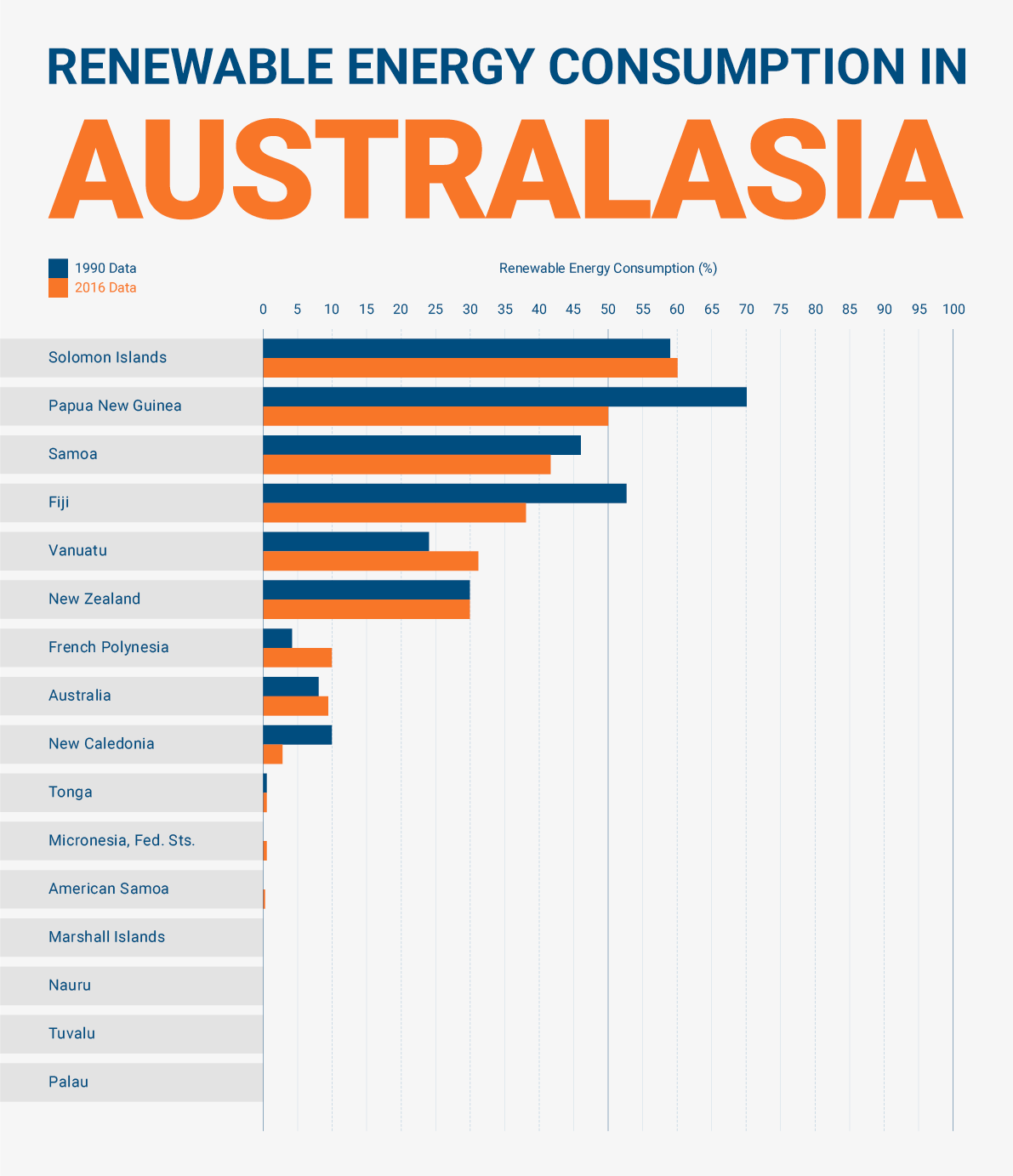 Australasia and Oceania is the most sparsely populated continent on earth (apart for Antarctica, obviously). Made up of the three giant islands in Australia, New Zealand and Papua New Guinea the continent is comprised of tropical rainforests, arid desert, volcanoes and dry grasslands.
So how does the Australasia and Oceania region compare in a global renewable context? Analysing data for 16 different islands in the region we found that the Solomon Islands had the highest consumption of renewables as a total of energy consumption at 62%, followed by Papua New Guinea’s 50% and Samoa’s 42%. But across Australasia the rates of renewable energy consumption to a total of energy consumption hits below 10%. The richest country in the region Australia is one of the biggest surprises with only 9% of their energy coming from renewable sources.
Most Used Renewable Energy Source – Worldwide
Australasia and Oceania is the most sparsely populated continent on earth (apart for Antarctica, obviously). Made up of the three giant islands in Australia, New Zealand and Papua New Guinea the continent is comprised of tropical rainforests, arid desert, volcanoes and dry grasslands.
So how does the Australasia and Oceania region compare in a global renewable context? Analysing data for 16 different islands in the region we found that the Solomon Islands had the highest consumption of renewables as a total of energy consumption at 62%, followed by Papua New Guinea’s 50% and Samoa’s 42%. But across Australasia the rates of renewable energy consumption to a total of energy consumption hits below 10%. The richest country in the region Australia is one of the biggest surprises with only 9% of their energy coming from renewable sources.
Most Used Renewable Energy Source – Worldwide
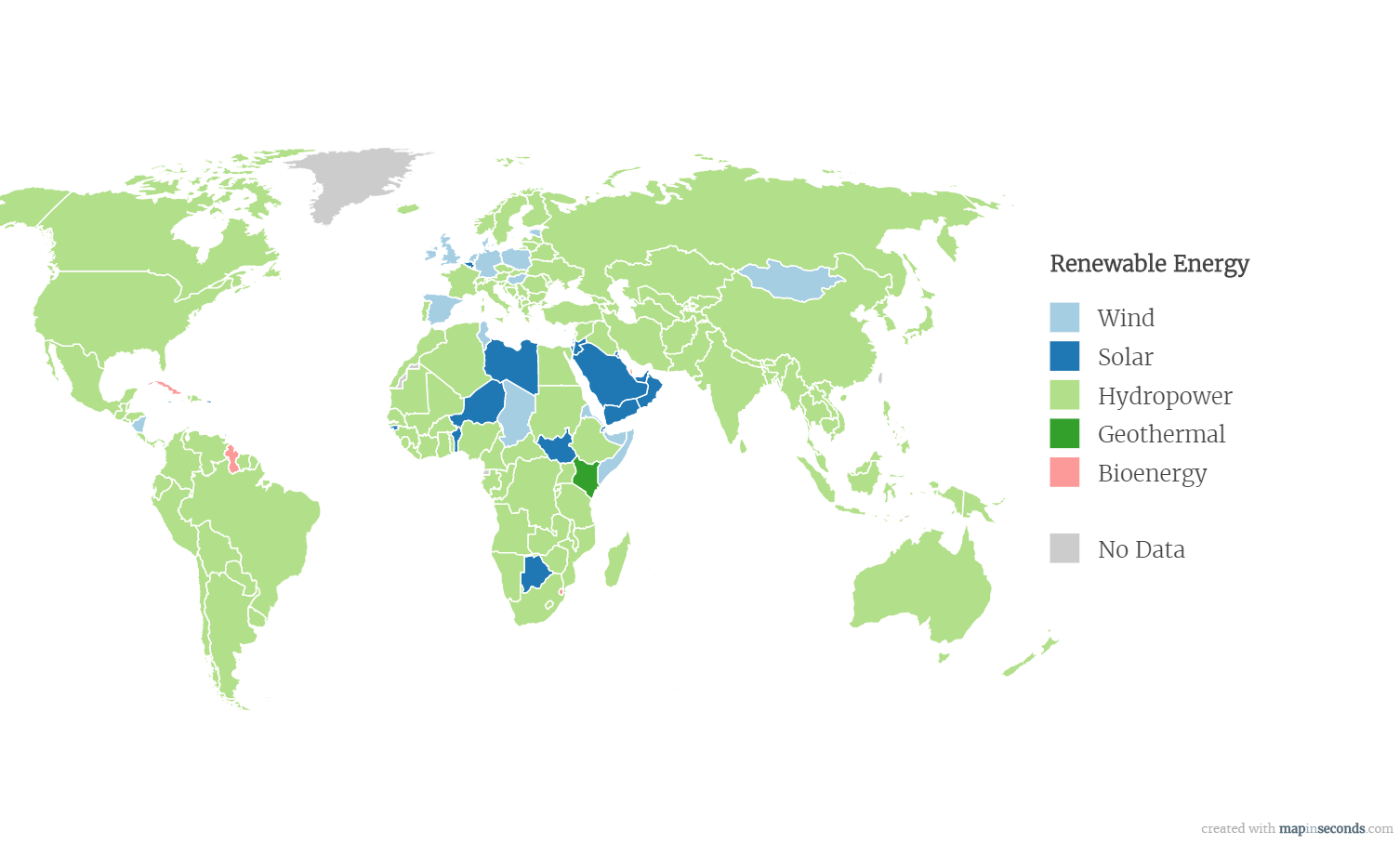 Next, we took a closer look at which of the main five renewables each country around the world utilises the most. We’ve seen that renewable consumption varies greatly from country to country, but how much does the type of renewable change from country to country?
Analysing a variety of datasets we found that hydropower is by far and away the most popular type of renewable energy. The only real exceptions were a cluster of countries in the Middle East and North East Africa who’ve embraced solar power, and a number of European countries in the likes of Germany, Spain and Poland who’ve embraced wind power. The other small exception is Kenya who surprisingly generates a large percentage of its energy from geothermal sources.
Interestingly, Kenya is one of the world leaders in renewable energies. Having embraced Geothermal in the Rift Valley, Kenyans have also embraced Wind, Hydro and Bioenergy in impressive numbers for an African country. In terms of MW capacity they generate 26% of Africa’s entire renewable energy. Impressive.
Top 10 Countries with Highest use of Renewable Energy – 2016
We also looked more specifically at which countries produce the most energy from renewable sources per renewable type. Analysing data from across the solar, wind, hydropower, geothermal and bioenergy industries we’ve noted down the top 10 in the graphic below. In terms of all round performance China is impressively the world’s greatest when it comes to renewable energy. Following hot on the heels in almost all renewable types is the United States.
While the two superpowers in the US and China featuring in the top 10 of this analysis will be of little surprise, there are some interesting countries featuring in the top 10 of each renewable type that may be a little more unexpected. The Philippines for example has embraced Geothermal energy to the tune of nearly 2000 MW capacity a year and they also feature in our top 10 for solar power too. Another surprise is Brazil, which features in the top 10 for bioenergy production, hydropower and wind power.
Top 10 Countries with Highest Use of Renewable Energy – 2000
So how have things changed over the last 16 years? To find out we’ve taken a closer look at the data per renewable type in the year 2000. Unsurprisingly, it will not be hard to believe that we are generating far more energy in 2016 with renewables than 16 years ago. For example in the year 2000 the top country in the United States was producing 595 MW of energy using solar power. In 2016, the top country in Japan is producing over 41,000 MW.
Another surprise is how the Germans have loosened their dominance over the renewable industry in the last 16 years. Featuring in the top three spots for almost every renewable type in the year 2000, they’ve now slipped down the leaderboard with countries like China and Brazil investing heavily into renewable energies.
Interestingly, you can see the German pattern in a number of European countries. In the year 2000, countries like the Netherlands, Greece and Switzerland featured in the top 10 for a range of renewable types. Today they have moved down the rankings with the likes of India, the Philippines and Turkey moving into the top 10.
Total Renewable Energy Analysis – Regional – 2000 – 2016
We also looked at the data from a wider more regional perspective. As you can see in the interactive below, in the year 2000, 75% of the world’s total renewable energy capacity was equally split between Europe, Asia and North America. South America, Eurasia, Africa and the Middle East make up the other 25%.
However, things have changed drastically on a regional level over the last 16 years. Today, Asia has grown to be the biggest generator of electricity from renewable sources making up 40% of the world total. Interestingly, Europe have maintained their share only losing 1% of the total capacity, while North America as a whole drops off quite significantly losing 7% of the total renewable energy share.
UK Wind, Solar, Wave, Tidal, Landfill Gas, Sewage Gas, Other Bio Energy
Next, we took a closer look at which of the main five renewables each country around the world utilises the most. We’ve seen that renewable consumption varies greatly from country to country, but how much does the type of renewable change from country to country?
Analysing a variety of datasets we found that hydropower is by far and away the most popular type of renewable energy. The only real exceptions were a cluster of countries in the Middle East and North East Africa who’ve embraced solar power, and a number of European countries in the likes of Germany, Spain and Poland who’ve embraced wind power. The other small exception is Kenya who surprisingly generates a large percentage of its energy from geothermal sources.
Interestingly, Kenya is one of the world leaders in renewable energies. Having embraced Geothermal in the Rift Valley, Kenyans have also embraced Wind, Hydro and Bioenergy in impressive numbers for an African country. In terms of MW capacity they generate 26% of Africa’s entire renewable energy. Impressive.
Top 10 Countries with Highest use of Renewable Energy – 2016
We also looked more specifically at which countries produce the most energy from renewable sources per renewable type. Analysing data from across the solar, wind, hydropower, geothermal and bioenergy industries we’ve noted down the top 10 in the graphic below. In terms of all round performance China is impressively the world’s greatest when it comes to renewable energy. Following hot on the heels in almost all renewable types is the United States.
While the two superpowers in the US and China featuring in the top 10 of this analysis will be of little surprise, there are some interesting countries featuring in the top 10 of each renewable type that may be a little more unexpected. The Philippines for example has embraced Geothermal energy to the tune of nearly 2000 MW capacity a year and they also feature in our top 10 for solar power too. Another surprise is Brazil, which features in the top 10 for bioenergy production, hydropower and wind power.
Top 10 Countries with Highest Use of Renewable Energy – 2000
So how have things changed over the last 16 years? To find out we’ve taken a closer look at the data per renewable type in the year 2000. Unsurprisingly, it will not be hard to believe that we are generating far more energy in 2016 with renewables than 16 years ago. For example in the year 2000 the top country in the United States was producing 595 MW of energy using solar power. In 2016, the top country in Japan is producing over 41,000 MW.
Another surprise is how the Germans have loosened their dominance over the renewable industry in the last 16 years. Featuring in the top three spots for almost every renewable type in the year 2000, they’ve now slipped down the leaderboard with countries like China and Brazil investing heavily into renewable energies.
Interestingly, you can see the German pattern in a number of European countries. In the year 2000, countries like the Netherlands, Greece and Switzerland featured in the top 10 for a range of renewable types. Today they have moved down the rankings with the likes of India, the Philippines and Turkey moving into the top 10.
Total Renewable Energy Analysis – Regional – 2000 – 2016
We also looked at the data from a wider more regional perspective. As you can see in the interactive below, in the year 2000, 75% of the world’s total renewable energy capacity was equally split between Europe, Asia and North America. South America, Eurasia, Africa and the Middle East make up the other 25%.
However, things have changed drastically on a regional level over the last 16 years. Today, Asia has grown to be the biggest generator of electricity from renewable sources making up 40% of the world total. Interestingly, Europe have maintained their share only losing 1% of the total capacity, while North America as a whole drops off quite significantly losing 7% of the total renewable energy share.
UK Wind, Solar, Wave, Tidal, Landfill Gas, Sewage Gas, Other Bio Energy
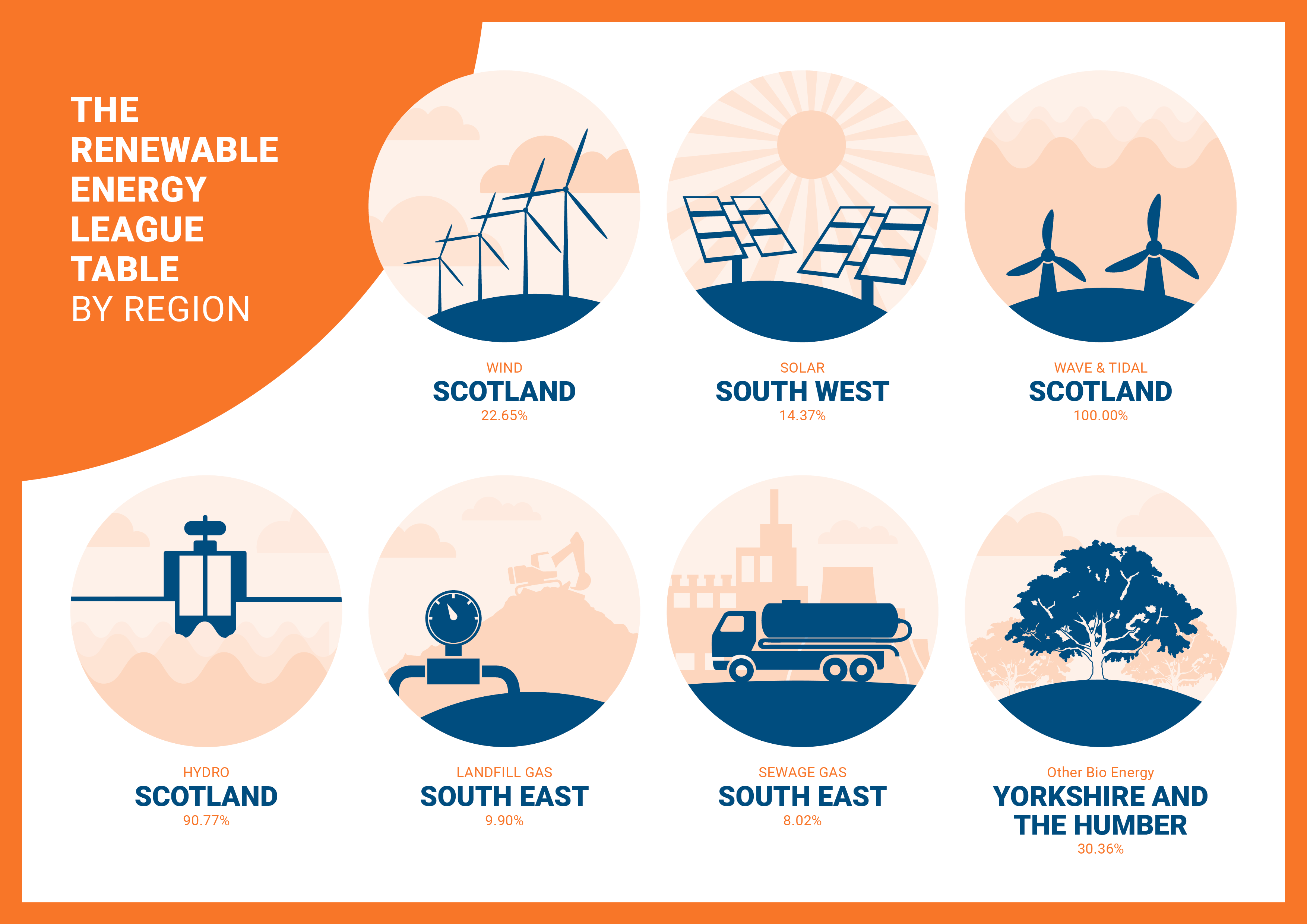 As a British company, we also decided to take a look at the renewable energy industry in the United Kingdom. As part of the European Union, the UK has been committed to a number of initiatives that aim to solve the issue of climate change. As a key player on these initiatives the UK has been at the forefront of the renewable industry providing development and new technologies that make renewables more efficient.
So what does the renewable energy industry look like in the UK and which regions are embracing renewable energy? Well, by far and away the biggest region committed to renewable energies is Scotland. They are the biggest generator of wind and hydropower energy in the UK and they are also generating a fair chunk of the bioenergy in the UK.
Another notable region is the South West of England. This region is producing 2000 MW of solar energy each year, which is nearly four times the amount of the next biggest generating region.
The poorest region in terms of producing renewable energy is London. In total renewable energy generation they are still below 1000 MW.
Sources
https://www.gov.uk/government/statistics/energy-trends-section-6-renewables
https://www.irena.org/Publications/ReportsPaper2014New.aspx?mnu=cat&PriMenuID=36&CatID=141&type=all
https://www.gov.uk/government/collections/renewables-statistics
https://www.eia.gov/
As a British company, we also decided to take a look at the renewable energy industry in the United Kingdom. As part of the European Union, the UK has been committed to a number of initiatives that aim to solve the issue of climate change. As a key player on these initiatives the UK has been at the forefront of the renewable industry providing development and new technologies that make renewables more efficient.
So what does the renewable energy industry look like in the UK and which regions are embracing renewable energy? Well, by far and away the biggest region committed to renewable energies is Scotland. They are the biggest generator of wind and hydropower energy in the UK and they are also generating a fair chunk of the bioenergy in the UK.
Another notable region is the South West of England. This region is producing 2000 MW of solar energy each year, which is nearly four times the amount of the next biggest generating region.
The poorest region in terms of producing renewable energy is London. In total renewable energy generation they are still below 1000 MW.
Sources
https://www.gov.uk/government/statistics/energy-trends-section-6-renewables
https://www.irena.org/Publications/ReportsPaper2014New.aspx?mnu=cat&PriMenuID=36&CatID=141&type=all
https://www.gov.uk/government/collections/renewables-statistics
https://www.eia.gov/ 
